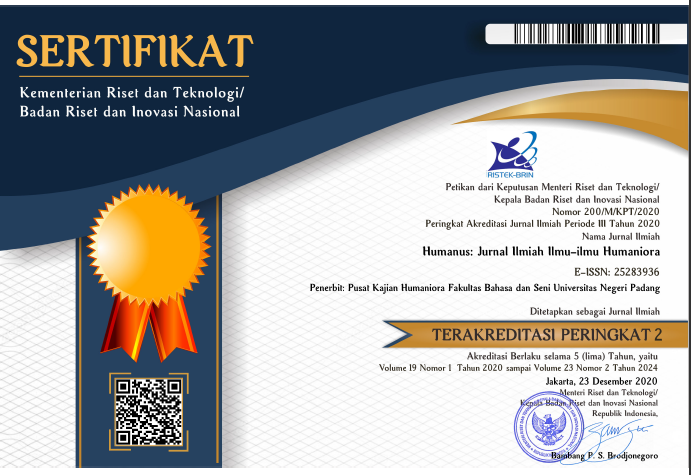Do We Need A Quality Assessment for Note-Taking Technologies in Technology-Assisted Interpreting? A Descriptive Study
 ), SF Luthfie Arguby Purnomo(2),
), SF Luthfie Arguby Purnomo(2), (1) Universitas PGRI Semarang
(2) Universitas Islam Negeri Raden Mas Said Surakarta
 Corresponding Author
Corresponding Author
Copyright (c) 2022 Humanus
DOI : https://doi.org/10.24036/humanus.v21i2.116893
Full Text:
 Language : en
Language : en
Abstract
Technology-assisted interpreting (TAI) signifies a binary concern encompassing not only the interpreting process but also the technology used. One of the technologies playing crucial roles in signifying the quality of interpreting is note-taking technology. Thereby we argue that note-taking technologies used in TAI require a specific quality assessment since they influence the process and result of interpreting. We propose a conceptual framework for a quality assessment specifically designed for note-taking technologies used in TAI by taking Aarseth’s textonomy theory (1997), Costa, Pastor, and Muňes’s technology aid based interpreting classification theory (2014), O’Brien and Toms’s user engagement theory (2008), Venkatesh and Davis’s technology acceptance model (2000), and Friedman’s immersion theory (2014). We propose that the note-taking technology quality assessment has to address three primary considerations. They are functional parameters, user’s function considerations, and interpreting types. Functional parameters, which assess the interaction between users and note-taking technologies, consist of engagement, acceptance, and immersion. User’s functions, comprising of interpretive, explorative, and configurative functions, assist the assessors in comprehending the characteristics of particular note-taking technologies. Interpreting types, classified based on the technology dominantly used in the interpreting process, helps the assessors indicate which technology fits what interpreting types.
Keywords
References
Aarseth, E. J. (1997). Cybertext: perspectives on ergodic literature. JHU Press.
Berber-Irabien, D. (2010). Information and communication technologies in conference
interpreting. Universitat Rovira i Virgili.
Bhatnagar, D., & Jancy, A. (2003). Technology assessment methodology. The experience of
India's TIFAC, TECH MONITOR, Special Feature: Technology Road-Mapping.
Blair, A. (2004). Note taking as an art of transmission. Critical Inquiry, 31(1), 85-107.
Bowker, L. (2002). Computer-aided translation technology: A practical introduction.
University of Ottawa Press.
Brandl, P., Richter, C., & Haller, M. (2010, April). Nicebook: supporting natural note taking.
In Proceedings of the SIGCHI Conference on Human Factors in Computing Systems (pp. 599-608). ACM.
Bridger, R. (2008). Introduction to ergonomics. Crc Press.
Cordingley, A., & Montini, C. (2016). Genetic translation studies: An emerging
discipline. Linguistica Antverpiensia, New Series–Themes in Translation Studies, 14.
Cronin, M. (2012). The translation age: Translation, technology, and the new
instrumentalism. The translation studies reader, 469-482.
Costa, H., Corpas Pastor, G., & Durán Muñoz, I. (2014). Technology-assisted
interpreting. MultiLingual, 143(25), 3.
Driessen, A. (2009). Ethical aspects of research in ultrafast communication. In Evaluating
New Technologies (pp. 11-19). Springer, Dordrecht.
Eskelinen, M. (2012). Cybertext poetics: the critical landscape of new media literary theory.
Bloomsbury Publishing USA.
Friedman, M. C. (2014). Notes on note-taking: Review of research and insights for students
and instructors. Harvard Initiative for Learning and Teaching, 1-34.
Gales, L., & Mansour-Cole, D. (1995). User involvement in innovation projects: Toward an
information processing model. Journal of engineering and technology management, 12(1-2), 77-109.
Harter, T., Vroegindeweij, S., Geelhoed, E., Manahan, M., & Ranganathan, P. (2004, April).
Energy-aware user interfaces: an evaluation of user acceptance. In Proceedings of the
SIGCHI conference on Human factors in computing systems(pp. 199-206). ACM.
Hartley, J., & Davies, I. K. (1978). Note‐taking: A critical review. Programmed learning and
educational technology, 15(3), 207-224.
Hockey, G. R. J., Briner, R. B., Tattersall, A. J., & Wiethoff, M. (1989). Assessing the
impact of computer workload on operator stress: the role of system controllability. Ergonomics, 32(11), 1401-1418.
Kiewra, K. A., Benton, S. L., Kim, S. I., Risch, N., & Christensen, M. (1995). Effects of
note-taking format and study technique on recall and relational performance. Contemporary Educational Psychology, 20(2), 172-187.
Lugmayr, A., Niiranen, S., & Kalli, S. (2004). World of Digital Interactive TV. In Digital
Interactive TV and Metadata (pp. 11-30). Springer, New York, NY.
McFall, R. (2005). Electronic textbooks that transform how textbooks are used. The
Electronic Library, 23(1), 72-81.
Melone, N. P. (1990). A theoretical assessment of the user-satisfaction construct in
information systems research. Management science, 36(1), 76-91.
Norberg, U., Stachl-Peier, U., & Tiittula, L. (2015). Speech-to-text interpreting in Finland,
Sweden and Austria. Translation & Interpreting, 7(3), 36-49.
O'Brien, H. L., & Toms, E. G. (2008). What is user engagement? A conceptual framework
for defining user engagement with technology. Journal of the American society for Information Science and Technology, 59(6), 938-955.
Pochhacker, F. (2008). Interpreting as mediation. BENJAMINS TRANSLATION
LIBRARY, 76, 9.
Pöchhacker, F. (2016). Introducing interpreting studies. Routledge.
Poupyrev, I., Tomokazu, N., & Weghorst, S. (1998, March). Virtual Notepad: handwriting in
immersive VR. In Virtual Reality Annual International Symposium, 1998. Proceedings., IEEE 1998 (pp. 126-132). IEEE.
Ribeiro, R. (2007). The role of interactional expertise in interpreting: the case of technology
transfer in the steel industry. Studies in History and Philosophy of Science Part A, 38(4), 713-721.
Rogers, E. M. (1986). Communication technology (Vol. 1). Simon and Schuster.
Schepman, A., Rodway, P., Beattie, C., & Lambert, J. (2012). An observational study of
undergraduate students’ adoption of (mobile) note-taking software. Computers in Human Behavior, 28(2), 308-317.
Sproull, L., Subramani, M., Kiesler, S., Walker, J., & Waters, K. (1997). When the interface
is a face. Human values and the design of computer technology, (72), 163.
Thüring, M., & Mahlke, S. (2007). Usability, aesthetics and emotions in human–technology
interaction. International Journal of Psychology, 42(4), 253-264.
Toledano-Buendía, M. C. (2013). Listening to the voice of the translator: A description of
translator’s notes as paratextual elements. Translation & Interpreting, 5(2), 149-162.
Venkatesh, V., & Davis, F. D. (2000). A theoretical extension of the technology acceptance
model: Four longitudinal field studies. Management science, 46(2), 186-204.
Venuti, L. (2017). The translator's invisibility: A history of translation. Routledge.
 Article Metrics
Article Metrics
 Abstract Views : 340 times
Abstract Views : 340 times
 PDF Downloaded : 96 times
PDF Downloaded : 96 times
Refbacks
- There are currently no refbacks.
Copyright (c) 2022 Humanus

This work is licensed under a Creative Commons Attribution-NonCommercial 4.0 International License.











